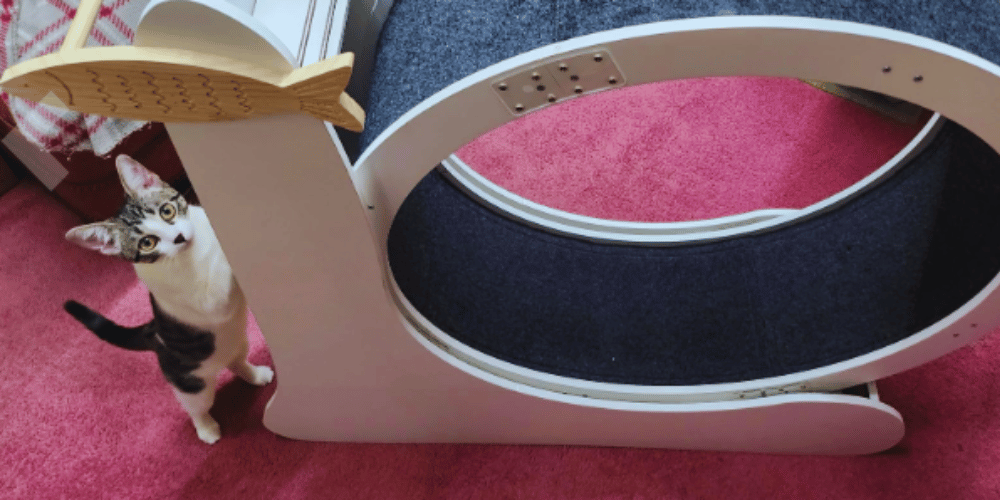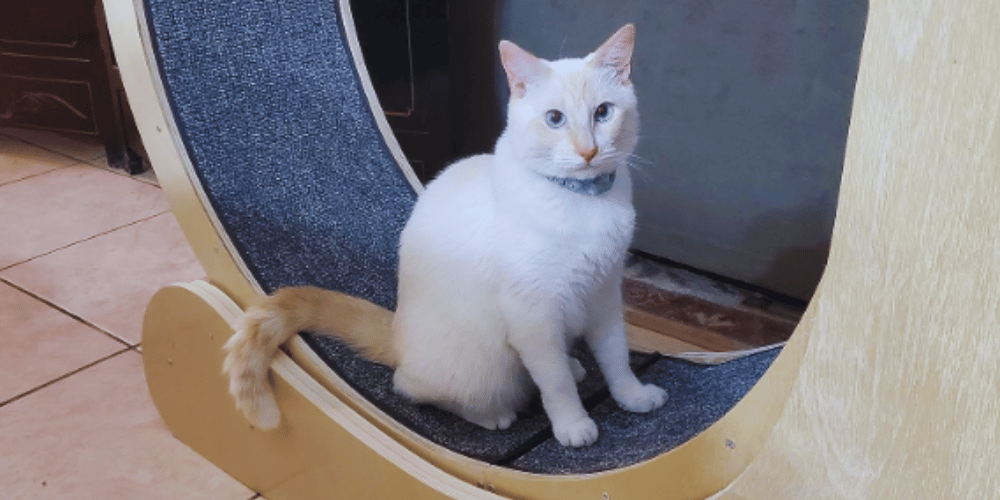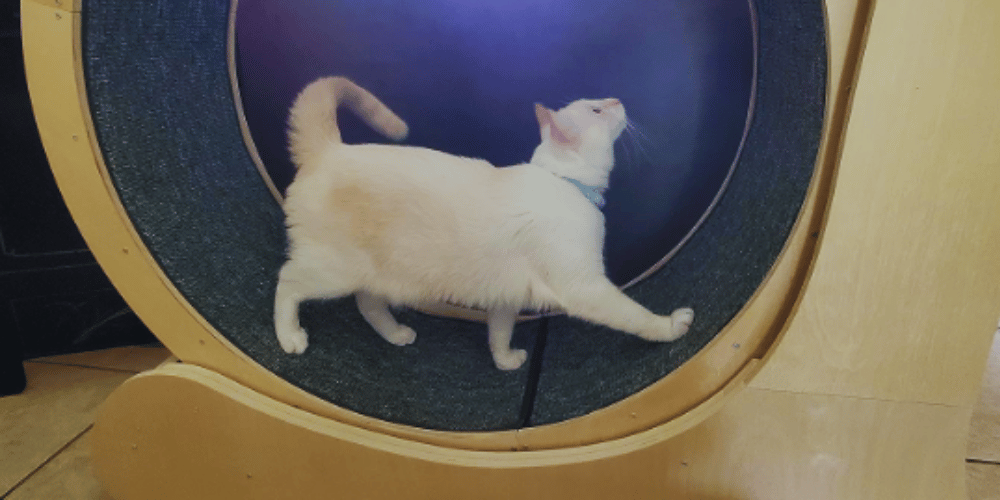Are you thinking about getting your cat a wheel for exercise or watching them happily prance around like tiny little hamsters?
If so, introducing your cat to the wheel properly will ensure that they are having fun and staying safe. While getting a wheel may seem daunting if it's a new concept for you, don't worry!
We have compiled some helpful starting points, tips and tricks for helping make this process as smooth and stress-free as possible.
Read on to find out how to introduce your feline friend to their brand-new exercise wheel in five easy steps!

Tips on Introducing Your Cat to a Wheel
Exercise is important for pets, especially for felines. They need to flex their muscles, run, climb, and play to maintain good health. However, not all owners can provide an outdoor environment for their cats to do such activities without supervision.
Fortunately, cat wheels have become popular in recent years as a perfect indoor exercise tool for cats, especially for apartment dwellers. Cat wheels are a great way to keep your cat healthy and entertained.
But if your cat is new to a cat wheel, you may find that they are hesitant to approach it. It is your role as a cat owner to put them at ease so they can start using the wheel. Here are some tips for introducing your cat to a wheel.
Let your cat observe the wheel
Before introducing your cat to the wheel, let them observe it first. Place the wheel in a room where your cat can see it from a distance.
This will allow your cat to familiarize themselves with the new object. Your cat can take a few days to examine the wheel and get used to it.
Be patient during this period and give your cat time to get comfortable with the new object.
Use treats and toys
Treats and toys are a good way to lure your cat towards the wheel. Place a few treats near the wheel, encouraging your cat to approach it.
You can also use toys to get your cat engaged. Your cat may start playing with the toy and end up on the wheel, getting familiar with it in the process.
Be Gentle
Introducing a cat to a wheel can be a challenging task, and it requires patience and gentleness. Don't force your cat to use the wheel.
Allow your cat to approach the wheel in their own time. If your cat seems agitated or nervous, stop the introduction and try again later.
Reward Good Behavior
When your cat shows positive behavior while using the wheel, give them a treat as a reward. This positive reinforcement teaches your cat that using the wheel is a good thing and encourages them to use it more often.
Make it Fun
Using the cat wheel should be a fun experience for your cat. Play with your cat and encourage them with treats and praise while they are on the wheel. Make it a fun bonding activity between you and your cat.
Introducing a cat to a wheel can seem daunting. However, by taking it slow and using treats and positive reinforcement, you can make the introduction a positive experience for your cat.
Introducing your cat to a wheel helps keep them healthy, active, and mentally engaged. Remember to be patient, and gentle, and make it fun.
Eventually, your furry friend will be spinning around the wheel, burning off energy, and having a great time!

FAQs: How to Introduce your Kitty to a Cat Wheel?
Cats are incredibly curious and active creatures, so it’s no wonder that many of them find the process of learning how to use a cat wheel so intriguing. However, you may be wondering what is required to introduce your kitty to this exercise tool – and we understand!
That’s why in our article today, we talk about FAQs so you can get familiarized with all the steps needed to bring home a new cat wheel for your cuddly companion.
From choosing the best one suited for your pet’s needs to acclimating them so they can take full advantage of its benefits, you will learn everything about making this challenging transition smoother while getting more quality bonding time with your furry friend.
Read on and arm yourself with knowledge!
What equipment do I need to introduce my cat to a wheel?
- To introduce your cat to a cat wheel, you will need the following equipment:
- A safe and sturdy wheel designed specifically for cats.
- Treats or toys to motivate and reward your cat during the training process.
- A quiet and comfortable space where your cat can focus and explore the wheel without distractions.
What should I expect during the training process?
- It's important to be patient and understand that each cat is unique. Here's what you can expect during the training process:
- Initially, your cat may be wary of the wheel. Give them time to approach it at their own pace.
- Use positive reinforcement techniques such as treats or toys to encourage your cat to investigate and step onto the wheel.
- Gradually increase the time and speed of the wheel to build your cat's confidence and comfort level.
- Some cats may take longer to adapt, so it's crucial to be consistent and offer plenty of praise and rewards.
What are the benefits of having a cat wheel for my cat?
- Introducing a wheel to your cat can provide several benefits, including:
- Physical exercise: The wheel allows your cat to engage in natural running and climbing behaviors, promoting physical fitness and weight management.
- Mental stimulation: Using the wheel can help reduce boredom and prevent behavioral issues by providing an outlet for your cat's energy.
- Bonding opportunity: Spending time together during the training process strengthens the bond between you and your cat.
- Enrichment: The wheel offers a new and exciting experience for your cat, stimulating their senses and curiosity.
What are some potential challenges I may face?
- Introducing a wheel to your cat can sometimes pose challenges, such as:
- Fear or hesitation: Some cats may initially be afraid of the wheel. Patience and positive reinforcement can help them overcome their fears.
- Lack of interest: Not all cats may immediately take to the wheel. Try using enticing treats or toys to generate curiosity and motivation.
- Space constraints: If you have limited space, consider choosing a compact wheel that fits well in your living area.
How can I overcome these challenges?
Here are some practical solutions to overcome potential challenges when introducing a wheel to your cat:
- Gradual introduction: Start by allowing your cat to explore the wheel at their own pace without any movement. Gradually increase the speed and duration as they become more comfortable.
- Positive reinforcement: Use treats, praise, and playtime to reward your cat for using the wheel. This will create positive associations and encourage them to continue using it.
- Consistency: Set aside regular training sessions to reinforce the habit of using the wheel. Be patient and consistent in your approach.
- Seek professional guidance: If you encounter significant challenges or your cat shows signs of stress or anxiety, consult with a veterinarian or an animal behaviorist for expert advice.
Remember, each cat is unique, so it's important to adapt these guidelines to suit your cat's individual needs and preferences. Enjoy the process of introducing your cat to a wheel and watching them benefit from this engaging form of exercise and play!

Introducing a cat to a wheel can be an enjoyable, bonding experience for both you and your pet. Be sure to always monitor the cat while they’re on the wheel, and never leave them unattended.
If you keep these guidelines in mind, it won’t take long for your cat to become a pro on their new wheel. Take the time to practice patience and enjoy building a relationship with your dear four-legged companion.
Start at a slow pace and gradually increase speed as the two of you get used to each other. Before long, your furry friend will learn how to maneuver themselves around their wheel with relative ease!
Best of luck on this journey - remember that it takes time for cats and owners alike to build trust and become comfortable with the new tool.
Thank you for visiting LegitLists we hope this helps you make a legitimate choice!






